Opinion
The state of the .300 Blackout is in flux today. That statement may seem like a negative, but the state of change that .300 BLK is in, is nothing short of a metamorphosis. In this short article series, I am going to delve into the dramatic changes and efforts made in the realm of this fantastic cartridge and give a look at where we started and where we are going.
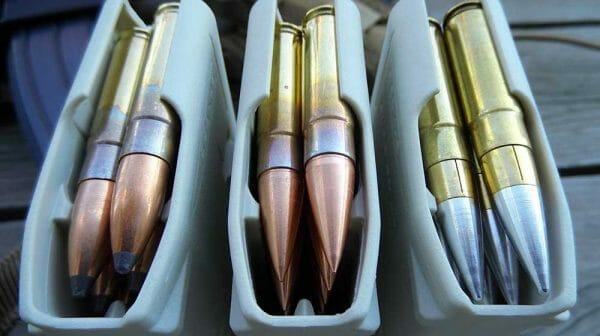
We live in a day and age where there are new cartridges popping up every day that are made to fit in an AR or a bolt action and there seems to be a similarly endless venture into filling every small and irrelevant niche that can be imagined. The .300 Blackout is a cartridge that, on paper, can be easily disparaged and dismissed, yet on sales numbers and product support it is impossible to ignore.
I believe that this comes down to several things and the American idea of what a rifle should be. The .300 Blackout defies the tradition of niche ammo. .300 Blackout is not typically a match-accurate round, can be hard to tune in a weapon, doesn’t display good trajectory on paper, and is not a round that can really be hot-rodded. There are lots of guys I know that hate it for the above reasons and can’t understand why ballistically superior rounds like 6.5 Grendel and 6.8 SPC aren’t more popular. The thing that they don’t get is that trajectory isn’t everything and means relatively little in the long run when it comes to the longevity of a successful cartridge.
The simple reason these other rounds haven’t achieved as much popularity is because there is a lack of understanding on behalf of those who developed them in relation to the consumers that will end up buying them. The .300 Blackout is a round that lacks in several areas by direct comparison, but will outlive the others simply because it makes the most sense to the consumer at large. It is a round that people want despite the attitude of the ballistics-obsessed. As a result, it has enjoyed a massive bloom of products and support. Literally dozens of manufacturers produce rifles in the caliber and many more make everything from ammo to dedicated magazines.
Live Inventory Price Checker

|
Herring Model 2024 300 Aac Blackout Lever Action Rifle - Herring Model 2024 300 Blackout 16.25'''' Bbl (1)10rd Mag Black | Brownells.com | $ 1199.99 |
|
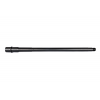
|
16" .300 Blackout Pistol Length AR 15 Barrel, Modern Series | Ballistic Advantage | $ 180.00 |
|
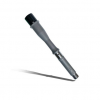
|
KAK SPL 1:5 5R 300 Blackout 8" Pistol Gas AR15 Barrel- Stainless | KAK Industry | $ 295.00 |
|
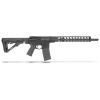
|
Lantac LA-SF15 .300 Blackout Recon Law 16" Bbl Rifle w/ Pistol Gas System 01-FA-300-RECL | EuroOptic.com | $ 1599.00 |
|
There isn’t a more popular new caliber than this in our day. Some, like the 6.5 Creedmoor, have enjoyed a following among long-range shooters and hunters, but as is the nature of fad cartridges, it is already being dethroned by other boutique rounds like 6mm Creedmoor. Half the guys I know that swore by a 6.5 now shoot 6mm and only a year or two has passed. Nobody that I know that made the switch to .300 Blackout has seen a reason get off the train and, as a result, incredible innovation is being made in the world of the cartridge.
Sig Sauer recently announced a gun, the Rattler, hailed as the world’s smallest rifle. Caliber? You guessed it: .300 BLK. Want a 78gr bullet that flies at 2800-2900fps from a 16” barrel while being match-accurate at 500 yards? Lehigh Defense makes that and it’s available off the shelf and I tested it in this series. How about a cartridge that you can load for anything from black bear and boars to coyote and deer that can do all of them just by switching out a magazine with your given choice in ammo? .300 Blackout has you covered.
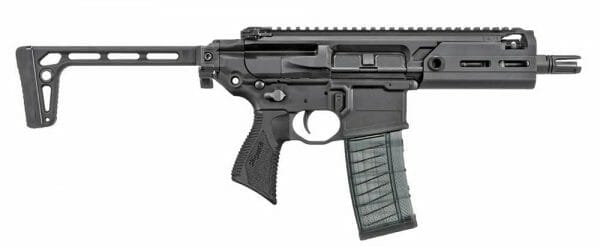
The most interesting thing that I think is coming of out of the popularity of the cartridge is the development in .30 caliber bullets. Just like the popularity and resulting advances of .380 ACP made .45ACP better, the advances in .308” diameter bullets has had an impact on our ideas of effectiveness and what it means to have a cartridge perform in our day.
As a baseline standard, Sig Sauer makes a solid copper 120gr hunting round loaded to 2250fps. The testing I did from a 16” barrel showed me that the bullet flew at an average of 2290fps. The ballistic snobs among you may turn your noses at this, but understand that this is an incredible achievement. The slower speed compared to bigger .30’s makes it necessary to garner the desired result with less out the gate. If you can make a bullet perform at 2290fps and deliver expansion and lethality, the technology can be translated to other calibers and designs. In a way of speaking, the limits on the .300 BLK are what make the end users so creative. It’s not a game of speed, but rather a challenge to exceed the limits over and over again.
For my testing factory ammo in this article, handloads soon to follow, I assembled a rifle that, I believe, contains some of the best parts for this caliber available today. I have previous experience with most of these companies and have come to trust the quality and reliability of their products. The core of this gun is a Faxon 16” barrel. Why a 16” and not a shorter one? Well, this is where we get into the idea that the .300 BLK was designed around short barrels but is not limited to them. I decided to do a 16” because it is a standard length for most people and there is tons of performance that can be tapped from it when the .300 BLK is loaded to perform in its supersonic form. Don’t worry; I will be looking at the advances in subsonic bullets soon, but we have to get through the supersonic deal first.
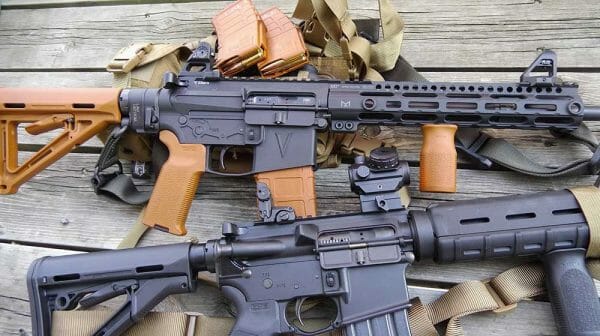
I believe that the .300 BLK is best in a light gun because of how minimal the recoil is to begin with. For this reason, I utilized the products of some of the same companies that recently appeared in my AR pistol build, such as the simply wonderful V7 Lithium receiver set, Midwest Industries rail, and Faxon lightweight bolt carrier group. These products are among the very best lightweight designs made in today’s market in my opinion. Another must for a lightweight rifle is the Scalarworks On Point Sights. I was one of the first to receive these great sights and as a seasoned iron sight competitor, I will probably never have a different set of sights on my AR rifles. They are easy to use and extremely well-made and you will be at a severe disadvantage with any other similar product.
Some unique features of the rifle are, as you may have noticed, the Bakelite-colored Magpul furniture and the very obvious SilencerCo ASR Brake that mounts like a suppressor. I went for a Russian theme on the build and thought that it would look cool, but it works great and gives the gun a really cool aesthetic all while reducing blast and recoil. I also added a LAW folder to allow the gun to fold just like an AK does.
Colluding with my Russian-themed rifle is a rather simple American affair. That rifle is old-school but wears a brand new HSGI sling. It is really interesting to test a modern-built .300 against an older 1:9 twist rifle with a 14.5” pin-and-weld barrel. It works, but it is rough by comparison and pretty much stock.
Building a 16” .300 to perform isn’t as easy as you might think. To get the gun to run as intended, I again used an adjustable gas block from Superlative Arms. This is a great addition and allows you to adjust the gun to function with everything from standard factory offerings to blistering 2800fps+ handloads.
Another addition to the build is something you can’t see. Brownells sent me a Geissele Super 42 braided buffer spring and buffer. This may seem irrelevant, but it is a great addition to a .300 because of the differences in gas pressure compared to a 5.56mm. The buffer is adjustable by means of tungsten weights and can be used to increase or decrease bolt cycle speed.
The next task to settle was the choice of trigger. I’ve tested a fair number of triggers in .300 BLK rifle and have always found that some of the high-tension speed triggers to choke up reliability because of the force necessary to cock them during cycling. This isn’t all guns and triggers, but I heartily recommend using a Geissele two-stage G2S trigger. It is a military trigger in appearance but breaks clean and allows for unparalleled control while firing.
The last thought on parts selection is a PRI Gas Buster charging handle. This may seem extraneous, but if you plan on shooting with a suppressor or with hot handloads, this accessory prevents gas-in-the-eye and is very functional and attractive to boot.
All these things, when compared to the older rifle, seem a bit much, but the Bakelite rifle is almost ten years removed from the M4-type gun. Things have changed and we know more now than we did, which is why I decided to put the two head-to-head for some of the testing.
The older rifle loses a little bit in speed to the Bakelite gun, but not much. Where the new gun shines is in weight savings and firing characteristics. With all the modern and advanced parts, the Bakelite gun handily outshoots the older one. The accuracy of the Faxon barrel far surpasses virtually anything else offered today and shooting at 500 yards using the Scalarworks OPS sights was a dream come true.
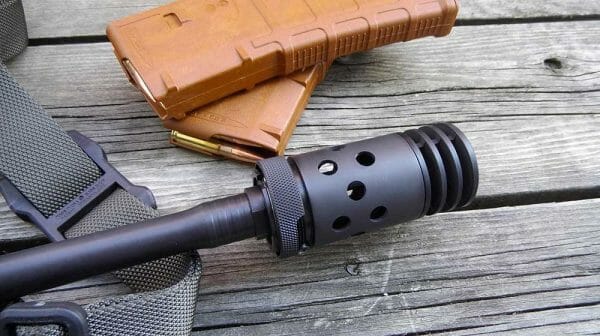
The thing about .300 Blackout is that it isn’t considered a long-range round, but I don’t think that that’s a downside of it. I chronographed and tested several factory offerings over an Oehler 35P on a 75 degree day while five feet from the muzzle. Readings are an average of ten shots. Accuracy is measured in inches at 100 yards and is an average three, five shot groups.
- Sig Sauer 125gr OTM————————-2125fps, 1.2”
- Sig Sauer 120gr Elite Hunting————–2290fps, 1.2”
- Hornady 110gr VMAX Black—————-2424fps, 1.9”
- Fort Scott 115gr Solid————————2235fps, 2.2”
- Lehigh 78gr HVCQ—————————-2818fps, 1.1”
- Black Hills 125gr——————————2141fps, 2”
- HSM 125gr Softpoint————————2146fps, 2.7”
- Armscor 147gr FMJ————————–1869fps, 3.3”
The accuracy out of the old gun wasn’t even close to the new Bakelite rifle. The slower twist rate and non-adjustable gas system made it so that the Lehigh loads wouldn’t cycle and caused a variety of other feeding and firing issues with anything but the Hornady load. Velocity didn’t vary too much, but accuracy wasn’t good. The old gun opened up group size by a multiple of 3 or 4 in most cases. The most accurate load from this gun was the HSM softpoint, which shot to 3.5”. The others were virtually all within the 5-7” range at 100 yards!
I don’t think this is the gun’s fault. It was built and has been shooting well for years, but it was made when the idea behind .300 Blackout was that it wasn’t all that accurate. Today’s .300 Blackout ammo in a modern built rifle like the Bakelite gun shows that the accuracy is there. As the cartridge has matured, the understanding of what makes it accurate has also come of age.
The interesting part of this whole deal is that the .300 Blackout has been considered as a good subsonic suppressor host, but today it is a real contender for a variety of roles thanks to how far we’ve come with it. A 78gr .30 caliber bullet at 2800-2900fps with a lower recoil impulse than 5.56mm and accuracy that is equal or sometimes better is a window into what the future could be as far as this cartridge is concerned. A 125gr bullet at 22-2300fps may be standard and is in the range of the 7.62x39mm, but a slick and aerodynamic .30 at .308 win speed can shave weight from our fighters loads, allowing a cost-effective shift from 5.56mm should the need arise. The 500-yard accuracy I was able to get using iron sights with this cartridge is nothing to sneeze at. I was able to hit, with irons mind you, an IDPA silhouette with minimal trouble. Moving to a ‘combat distance’ inside 300 yards, I was able to deliver easy hits with a 100-yard zero and a bit of hold over/under. The combination of parts on my Bakelite gun allowed for me to stay on target under recoil and deliver hit after hit.
The cartridge has matured now to the point where, for end users with multiple uses for one gun, near perfection has been achieved. The effectiveness and wide range of options make it a suitable candidate for nearly any rifle-related task and it can be easily adapted to ammo from under 1000fps to upwards of 2800fps.
In my next articles, I will be talking about the advancements in weapons that are designed around this fantastic cartridge and how to handload for it using today’s most innovative powders and bullets. There is just so much going on with this caliber that I can’t even get the words out on my keyboard faster than companies can produce game-changing products!
Special thanks to:
- Brownells
- V7 Weapons
- Faxon Firearms
- LAW Tactical
- SilencerCo
- Hornady
- Sig Sauer
- Magpul
- ScalarWorks
- Lehigh Defense
- HSM
- Armscor
- Black Hills
- Fort Scott Munitions
About Josh Wayner:
Josh Wayner has been writing in the gun industry for five years. He is an active competition shooter with 14 medals from Camp Perry. In addition to firearms-related work, Josh enjoys working with animals and researching conservation projects in his home state of Michigan.


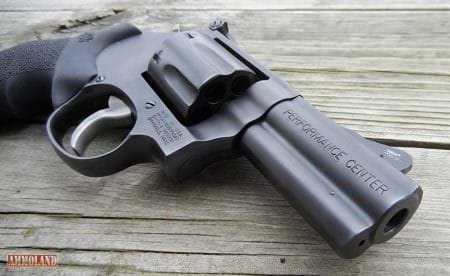

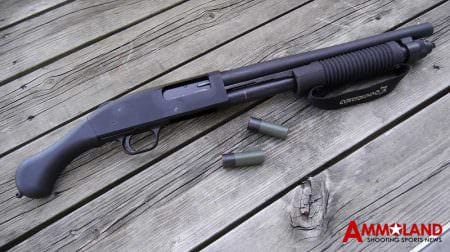
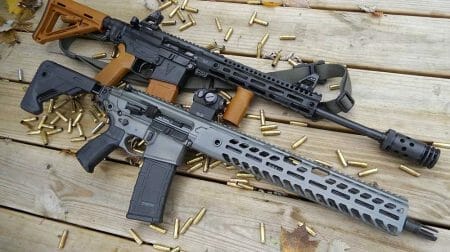
There is not a lot to dislike about a 300 BK but I really don’t understand the “desire” to try to develop ammo designed for long distance. If you are going to shoot 78 Gr pills in it, you may as well stick to 77 grain 5.56. There is no advantage in the .308 caliber lighter round. The 300 BK is a tool that excels at a certain job, suppressed subsonic and close quarters engagement. Trying to push it to do other things is a waste of time and effort because at long distances the expansion rate is zero so… Read more »
@Roy, You took the words right out of my mouth! More power to the guys who love to Tinker, experiment, and spend a whole lot more money than I even make gross a month, on various builds! However, my goal is to have a caliber in a rifle that I can shoot accurately, with readily available and munition, that I can purchase at a reasonable cost! The venerable thirty-ought-six can provide Superior ballistics, in real-world terms not just paper, from a basic bolt-action weapon, and bring down anything from a coyote to a bull moose! During World War II, it… Read more »
What was the twist rate on the newer rifle? The older one i believe was 1 in 9 twist rate. If i overlooked the rate i do apologize.
His new barrel was 1:8
But my rifle uses a 1:5 which achieves better accuracy for subsonic
And Roy gets owned!
Thanks for the In-Depth and Informative 300 Black Out Article J.R.!
A 300 Black-Out Rifle is my home defensive choice.
I will let you know if the intruders have any complaints!
Truly one of the best articles I’ve read regarding the .300 Blackout.
Excellent article and interesting comments from knowledgeable readers.
Please address this quesitons:
Using a SBR like Josh’s example of the Sig Rattler in 300 ACC, with subsonic ammo, how is the performance of the firearm and ammo affected? if any? Would such a configuration be an ideal personal defense system, or something milder like a Sig MPX in 9mm suppressed? Does not the 300 ACC in subsonic really perform like 45ACP?
All of you have much greater experience that I do, but simple questions for a simpleton, sincerely appreciate your comments, and advice….Thanks
As far as performance on the gun, standard 300 blk ammo is designed to fully burn in the first 8 inches so it is a perfect sbr round
I have had friends who jumped on the .300 Blackout bandwagon early on and they still like it. The majority of them are shooting from an AR platform, but one chose a Ruger American bolt action rifle chambered in .300 Blackout. When I got to shoot the .300 Blackout in the bolt gun and saw the results I became convinced. A great article on an outstanding round. Thanks.
Great article and I love your enthusiasm for the cartridge. As a 24 year and counting vet, one might think I could be a bit bias in my views when discussing AR platforms and ammo, but i have enjoyed tinkering with just about every option there has been. My first alternative build (what i refer to other than 5.56) was a 6.5 Grendel. It was a 20in heavy that i found pleasure in putting together with the best parts I could get on an Uncle Sam salary… That being said, it was a bargain build by every definition of the… Read more »
Nice article, Josh. 300BLK is certainly a flexible cartidge, and, relatively simple to build up a new upper for existing MSR15 lowers. I started in the 300BLK game focused on suppressed, sub-sonic, SBR build(s). Nary a hiccup and very impressed with performance using 208AMAX and 220SMKs. While an adjustable block is not ‘needed’ for those builds, I still used SLRs Sentry7 to tune the gas as it could be taken WAY down from full-gas, creating an even more mild, yet fully reliable, impulse. I’ve since rolled a few full-length (16″) uppers for use with heavier 300LK bullets, and continue to… Read more »